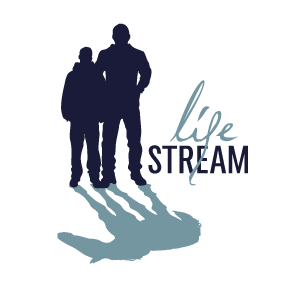NOTE Details on Covid 19 precautions below
Showing up to a “therapy” appointment is a big deal. Letting a stranger stick their nose in your business is well, kinda weird. Ultimately we’re just two folks hanging out together, talking or doing stuff.
We support folks ages 13 to 64 and families. Clients under 18 must verbally consent to treatment.
All of the approaches we use are intended to change your unconscious responses to the world and allow help you learn self-regulate internally. Awareness leads to changes in your neuro-functioning. These changes in your neural pathways provide healing from prior traumatic experience and impact your behavior in all relationships.
Brain Spotting
Toggle Content goes here
Covid 19 precautions as of 11-02-2023
Proof of vaccination + booster since Sept 1 2023 (bivalent) is required. A picture of vaccination/booster card must be uploaded, by each participant, to electronic health record.
All clients are expected to follow CDC recommendations for testing and quarantine/isolation following exposure to someone with Covid.
I strongly prefer folks having at least negative rapid test (rather than a home test) done within 3 days following exposure. A negative PCR test is the best assurance.
Masks are no longer required in session for indoors. The Oregon Health Authority approved mask less offices for health care providers April 3, 2023.
If you prefer to wear a mask I will also wear one in session. I have 3 layer masks available if wanted. I recommend (not require) N95 or 3 layer instead of cloth masks.
Plastic face shields, neck gaiters and bandanas are not acceptable alternatives to masks.
- Larger than typical office space of 18 x 26 with 12 foot ceiling.
- We can easily sit 6+ feet apart
- One or two windows open.
- Two HEPA filter UV air purifiers running
Additional considerations for evening group sessions:
- 8 folks maximum including myself
- In the circle we can spread out 5 feet apart from the person next to us
- A hybrid video option will be available, if needed, for a participant in a given week. This will be due to family/work quarantine necessitating staying home.
Polyvagal Theory -- The foundation
Polyvagal Theory — Detection
The autonomic nervous system controls body function (heartbeat, breathing, digestion, etc.) without thinking. These automatic actions are affected by our unconscious experience of the world.
click link–>BEGINNER’S GUIDE TO POLYVAGAL THEORY
by Deb Dana, LCSW is an easy to read, 8 page introduction.
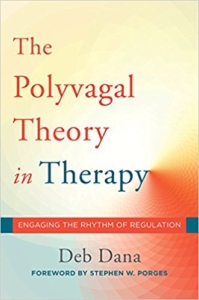
The autonomic nervous system is made up of two main branches, the sympathetic and the parasympathetic, and responds to signals and sensations via three pathways, each with a characteristic pattern of response. Through each of these pathways, we react “in service ofsurvival”.
The sympathetic branch is found in the middle part of the spinal cord and represents the pathway that prepares us for action. It responds to cues of danger and triggers the release of adrenaline, which fuels the fight-or-flight response.
In the parasympathetic branch, the remaining two pathways are found in a nerve called the vagus. Vagus, meaning “wanderer,” is aptly named. From the brain stem at the base of the skull, the vagus travels in two directions: downward through the lungs, heart, diaphragm, and stomach and upward to connect with nerves in the neck, throat, eyes,and ears.
Neuroception is the reactions, in a specific order and in predictable ways, that have been wired in us for millions of years. The evolutionary hierarchy of our responses from oldest to newest (bottom of diagram to top of diagram 3, 2, 1) are:
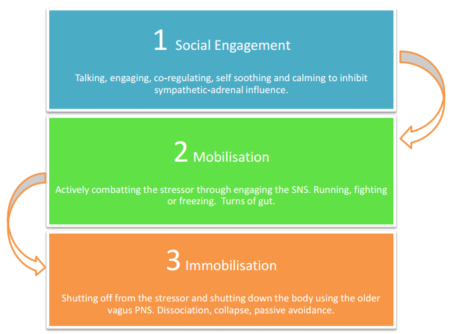
3. immobilization due to fear of death (shutdown/play dead)
2. mobilization due to sense of danger (fight/flight)
1. social engagement due to feeling safe (love, learning, creativity, growth and change)
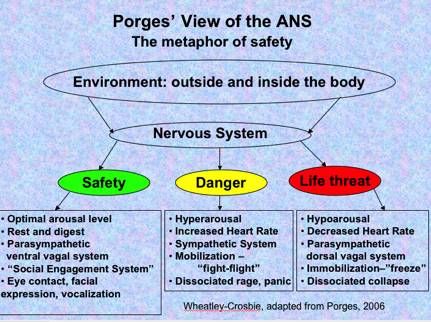
Here’s a Ted talk style video that’s pretty entertaining. It reviews Polyvagal theory in a more general way rather than only focusing on trauma. The speaker is no relation to Dr. Porges.
Neurobiology (Your Brain)
Neurobiology — Perception
Perception is only possible if we’ve move from danger into safety through our autonomic detection system.
- Until age 30 our brain develops from the bottom to the top and inside out– from the brain stem (simple “lizard brain”) to the limbic system (mammal brain) to the cortex (human brain).
- Positive or negative experiences that occur (Adverse Childhood Experiences or Traumatic experiences as an adult) alter the brain or leave it underdeveloped in those areas.
- When one or more areas are impacted it can have a cascading effect. Positively and negatively.
- Healing can occur at any age.
Evolutionary Brain Development
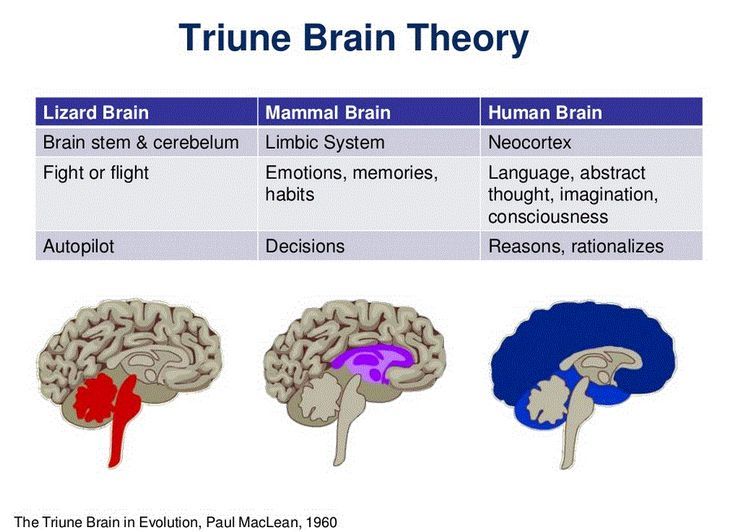
The short video uses the Dan Siegel’s brain model to demonstrate the automatic triggering that happens before we can even “think” about it. “Flipping our lid”
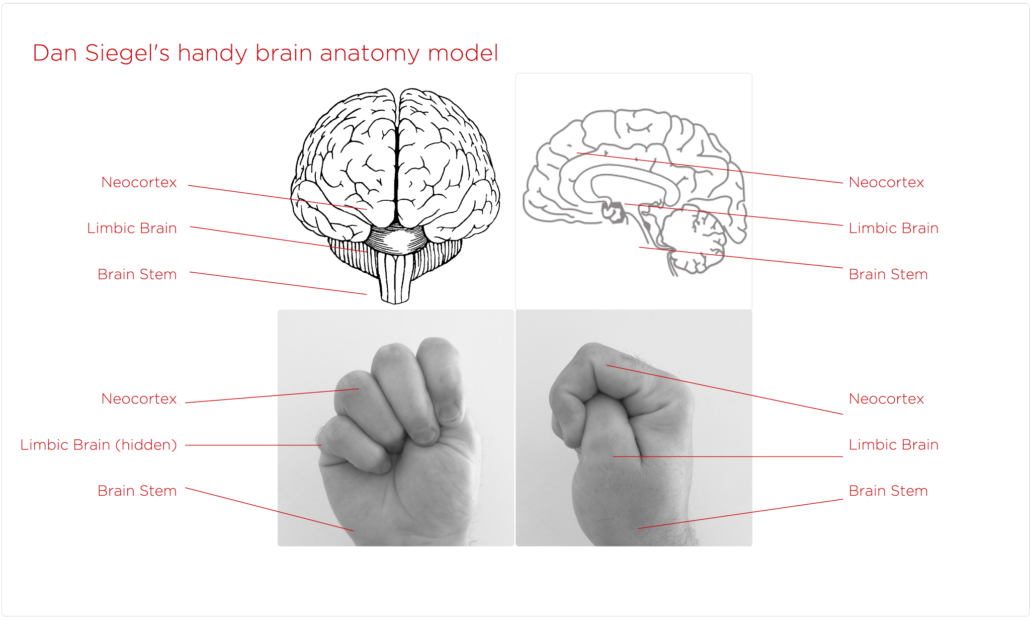
Resiliency -- Our Capacity to handle stress
- Sleep
- Diet (food and limiting substances that interfere with capacity building and maintenance)
- Exercise
- Oxygen — Belly Breathing and intentional breathing
- Connection
ADHD in Adults
Attention Deficit Hyperactivity Disorder in Adults
Attention Deficit Disorder Association (Adults with ADHD)
CHADD (Children and Adults with ADD)
The American Professional Society of ADHD and related disorders
Mindfulness | Self Compassion | Gratitude
Mindfulness | Self Compassion | Gratitude
Mindfulness fosters self compassion, connectedness, co-regulation of emotion and resilience. There are many mindfulness techniques. Meditation is one type of focus on mindfulness. Meditation practices have been around for a few thousand years with Yoga, Contemplative Prayer, Tai Chi, Buddhism, etc.
“Mindfulness is awareness that arises through paying attention, on purpose, in the present moment, non-judgmentally…” Dr. Jon Kabat-Zinn
Here’s a sweet video with kids demonstrating simple meditation to deal with stress.
Here’s 4 teens talking about the benefits of mindfulness from a Portland based program called Peace in Schools
In 1979 Dr. Jon Kabat-Zinn started Mindfulness Based Stress Reduction while at the University of Massachusetts Medical Center.
Since MBSR started many programs and variants have been developed including Mindfulness being key component in Dialectical Behavioral Therapy. The first research on DBT was published by Dr. Marsha Linehan in 1991
Experiential & Adventure Based Therapy
Experiential & Adventure Based Therapy
Adventure therapy (AT) is defined as “the prescriptive use of adventure experiences provided by mental health professionals, often conducted in natural settings, that kinesthetically engage clients on cognitive, affective, and behavioral levels”
- The issues we discuss in session come directly from the experience occurring in the moment.
- We have the opportunity to deal with the issues right there, at the point of performance.
- Shared experience enhances the relationship of both you and I.
- The potential transfer of learning from the therapy setting to your real life is improved by the focus and relevance of the process.
- It makes no difference whether we are inside, outside or hanging with the herd.
While I offer experiential activities in the office, in facility private yard and equine assisted psychotherapy other activities can be set up for individuals, co-parents and families upon request.
- Challenge ropes courses (low and high)
- indoor climbing walls
Trauma Informed & Healing Centered Care
Trauma Informed Care
The Division of Violence Prevention at the Centers for Disease Control and Prevention (CDC), in partnership with Kaiser Permanente, conducted a landmark ACE study (Adverse Childhood Experience) from 1995 to 1997 with more than 17,000 participants. The study found:
- ACEs are common. For example, 28% of study participants reported physical abuse and 21% reported sexual abuse. Many also reported experiencing a divorce or parental separation, or having a parent with a mental and/or substance use disorder.
- ACEs cluster. Almost 40% of the Kaiser sample reported two or more ACEs and 12.5% experienced four or more. Because ACEs cluster, many subsequent studies now look at the cumulative effects of ACEs rather than the individual effects of each.
- ACEs have a dose-response relationship with many health problems. As researchers followed participants over time, they discovered that a person’s cumulative ACEs score has a strong, graded relationship to numerous health, social, and behavioral problems throughout their lifespan, including substance use disorders. Furthermore, many problems related to ACEs tend to be comorbid or co-occurring.
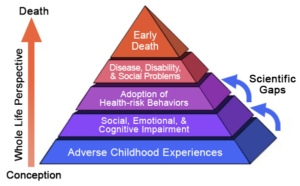 Research on the impact of complex Adverse Childhood Experiences in the past 15 years has shifted our perspective.
Research on the impact of complex Adverse Childhood Experiences in the past 15 years has shifted our perspective.
Take the ACE quiz yourself.
Oprah’s reporting on CBS’s 60 minutes in the spring of 2018.
Traumatic experiences in adulthood can be just as impactful. For healing professionals secondary trauma is an unfortunate “given” in our work supporting others who’ve experienced trauma themselves.
The lengthy text below includes excerpts from the Natural Lifemanship™ site. I couldn’t say it better.
The National Center for Trauma-Informed Care defines trauma-informed approaches and trauma-specific interventions as based on principles “designed to address the consequences of trauma in the individual and to facilitate healing.”
It was formerly believed that psychological and behavioral disorders related to child maltreatment were caused by irreversible brain damage. We now know that, except in rare cases, irreversible brain damage is seldom the case. Rather, the experience of complex (i.e., chronic, unpredictable) trauma leads to physiological adaptations in the way that the brain functions. Thus, the physiological functions that ensure survival (the nervous system’s fight, flight, or freeze response) become stronger and more efficient while those that compete with the survival instinct (thinking, planning, impulse control) remain weaker and disorganized.
When people live in a state of fear and uncertainty, they naturally become hypervigilant. In a healthy functioning individual, hypervigilance will arise when necessary, but the individual will return to a state of calm when the threat is no longer present. It is well known that chronic traumatic stress, such as that experienced by soldiers living in combat zones and refugees, often leaves its mark on otherwise healthy adults in what we commonly call PTSD, or Post-Traumatic Stress Disorder. We now also know that the brains of children who have experienced complex relational trauma have developed in such a way that they live in an almost constant state of alarm that may instantly progress to fear or terror for no apparent reason.
Collaborative Problem Solving
Collaborative Problem Solving
Collaborative Problem Solving is an evidence-based model that has been adopted across multiple states, school systems, psychiatric hospitals and juvenile justice settings as a best practice. CPS is applicable across all professional environments when trying to understand and engage kids, or diffuse their challenging behavior.
ALL KIDS WANT DO WELL, IF THEY CAN
if they can’t something is getting in the way. We need to figure out what, so we can help.
The Collaborative Problem Solving approach by Think: Kids, at Massachusetts General Hospital, is a parenting method that calms behavior challenges, opens up new pathways of thinking, and builds the skills to meet expectations. Helping your child improve areas like frustration tolerance, flexibility and problem solving can improve the relationships of all members of the family.
Skill vs. Will
Research conducted by Think: Kids shows that in family work there is statistically and clinically significant reduction in symptoms and severity of Oppositional Defiance Disorder as well as parenting stress. Also noted has been significant improvement in parental competence, child autonomy and parent-child interaction.
CPS uses guided assessment by family members to figure out:
- Challenging behaviors
- Problems to be solved
- What are the lagging skills that if present would prevent the behaviors and problems?
The goal is to discover and address lagging skills rather than seeing the behaviors as, as attention-seeking, manipulative, limit-testing, or a sign of poor motivation.
Skill Categories:
- Language and Communication
- Attention and Working Memory
- Emotion and Self Regulation
- Flexible Thinking
- Social Thinking
The three strategies CPS identifies are:
- Plan A — Imposing the adult’s will
- Plan B — Solving the problem collaboratively
- Plan C — Dropping the adults expectations (for now not permanently)
Co-Regulation is critical to this process. And very challenging, especially for parents with years of “practice” and patterns of communication doing it differently. Both of us must stay in the “safe” zone throughout to allow the process to succeed.
When talking with others (creating Plan B) the steps are:
- Empathize — clarify the others concerns
- Share your own concerns
- Invite the other person to brainstorm solutions with you so you can come up with one or more that are both practical and mutually satisfactory.
Some parents may look at the material and say their child has not had adverse childhood experiences (trauma) so this work is over kill. The CPS process is about connected relationships supported by co-regulation of emotions.
Collaborative Problem Solving & horses
One of the big pieces of CPS work is teaching parents how to create a safe place for their children and co-regulation. Horses can help with this in learning about connected relationship to interact in ways that are intentional and offer choice to the child. Also the work strengthens and builds neural pathways, in all family members, that are part of learning lagging skills and ways to respond.
For parents and families who have used CPS before our equine assisted psychotherapy can enhance and strengthen the work you have done.
- Experiential Learning and practice are a given.
- Rhythmic, Repetitive and Relational issues are a constant.
- Lagging skill learning and enhancement in emotional regulation and self regulation are a consistent focus as well.
- We believe the entire Plan B process can happen more smoothly due to the presence of the horses.
Current Oregon Parent Training Groups (including online) scroll down for Oregon specific.
Equine Assisted Psychotherapy
Equine Assisted Psychotherapy
NOTE: This work is primarily ground based, not about teaching horsemanship. No horse experience is needed.
Polyvagal theory taught by horses?
- Horses, mules and donkeys are prey animals and only care about right now, not yesterday or tomorrow. Dogs and cats are awesome but are predators and have a much different response and interaction with humans.
- Is what’s happening right now safe or unsafe? Equines are great teachers in being in the moment, fully alive and aware of their bodies.
- The patterns humans experience in relationship are observable and usually repeated in working with the equines.
The Equine Assisted Growth and Learning Association (EAGALA) provides our certification. This is a brief video showing an overview of the importance of a structured approach.
“A boy, a mustang — a healing relationship” is a ten minute video for Spirit Reins in Texas that gives a nice overview of Natural Lifemanship. It features former staff Tim Jobe and Bettina Shultz-Jobe, NL co-founders.
What goes on in an EAP Session?
In some ways an EAP session has the same structure as a typical office based one. There are a number of different types of therapy models and approaches that work with horses. We base our work on supporting you feeling safe and experiencing relationship.
NOTE: This work is primarily ground based, not about teaching horsemanship. No horse experience is needed.
- Our intake sessions are a minimum of two hours to allow time for both initial information gathering/sharing and time with the herd.
- We prefer two hour sessions. These can be bi-weekly rather than weekly. This gives more time for depth in the process with the equines.
We use the emWave2 portable HeartMath device at times to support the process of emotional regulation.
Whether individual, family or co-parent focused, session length is usually 50 minutes (extended session time is possible with prior arrangement) and follows a loose pattern:
- You will work with a team including myself, a certified Equine professional and one or more horses. mules or donkeys.
- Grounding activities such as drumming or standing meditation/breathing. This helps us be present and enter the paddock or arena as present as we’re able to be that day.
- Observation of the herd
- Selection of the mule/ horse/donkey partner you’d like to work with this session. We encourage sticking with one partner over time to build relationship but that’s not a rule in any way.
- Activities working on co-regulation of emotions with the equine
- Authentic relationship focusing on connectedness, attachment, detachment.
The process may include:
- Mindful approaches to being present, self compassion and gratitude.
- Education about polyvagal theory, brain development, trauma, relationship, etc.
- Debrief or processing session time
- Thoughts about preferences for the next session
Group sessions are 90 minutes long. The process is similar with time included for feedback and reflection from other group members.
Voluntary “Task work” will be provided, on password protected pages on our site, with links to additional information to learn and reinforce your growth between sessions.
